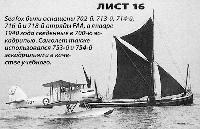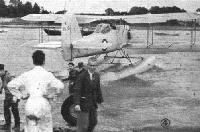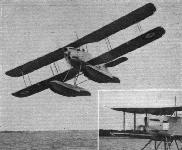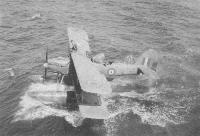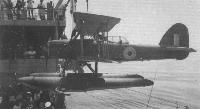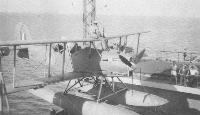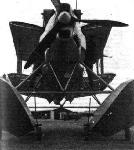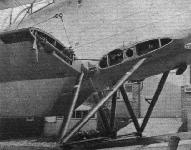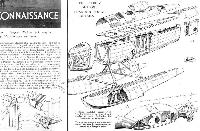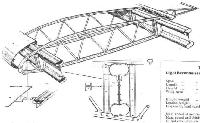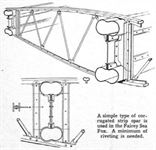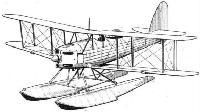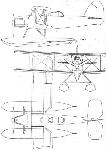
Описание
Страна : Великобритания
Год : 1936
Двухместный поплавковый разведчик-корректировщик
Seafox
Корабельный катапультный разведчик. Одномоторный цельнометаллический биплан, установленный на два поплавка. Создан в КБ фирмы "Фэйри авиэйшн" под руководством М. Лобеля. Предназначался для крейсеров.
Опытный образец биплана "Сифокс" впервые взлетел 27 мая 1936 г. Серийное производство началось в апреле 1937 г. на заводе "Фэйри" в Хэмбле. Всего построено 66 экз.
"Сифокс" состоял на вооружении британского флота с весны 1937 г.
Экипаж - 2 чел. Двигатель "Репьер" VI. Вооружение 1х7,69, бомбы до 200 кг.
В 1939 г. разведчики "Сифокс" стояли на ряде крейсеров флота Его величества. В декабре один из таких самолетов успешно корректировал огонь английских кораблей в бою у Рио-Плата, когда был серьезно поврежден немецкий "карманный линкор" "Адмирал граф Шпее". Это был первый случай корректировки огня флота во Второй мировой войне. Эти машины применялись и в Средиземноморье, в частности - при обороне Крита в мае 1941 г.
"Сифокс" сняли с производства в 1938 г., с вооружения их начали снимать в 1942 г., но некоторые самолеты эксплуатировались до начала 1943 г.
"Сифокс"||
Размах:||12,2 м
Длина:||10,8 м
Моторы, количество х мощность:||1х 395 л. с.
Взлетная масса, максимальная:||2464 кг
Максимальная скорость:||200 км/ч
Практический потолок:||3350 м
Дальность:||710 км
Описание:
- Seafox
- Fairey Seafox
- Flight, December 1937
FOR LIGHT RECONNAISSANCE
Фотографии
-
Jane's All the World Aircraft 1938 / 03 - All the world's aeroplanes
Регистрационный номер: K4304 The Fairey "Seafox" Two-seat Reconnaissance Seaplane (375 h.p. Napier "Rapier" engine).
-
Flight 1937-11 / Flight
Регистрационный номер: K8575 [5] The Seafox light reconnaissance seaplane with 16-cylinder Rapier engine. The type is in service with the Fleet Air Arm.
-
Мировая Авиация 126
Регистрационный номер: K8587 Seafox были оснащены 702-й, 713-й, 714-й, 716-й и 718-й отряды FAA, в январе 1940 года сведенные в 700-ю эскадрилью. Самолет также использовался 753-й и 754-й эскадрильями в качестве учебного.
-
Flight 1939-05 / Flight
The Fairey Seafox is a light reconnaissance biplane used mainly from cruisers. It has a 16-cylinder Napier Rapier engine.
-
Flight 1937-12 / Flight
Регистрационный номер: K8575 [5] Delivery commenced of Fairey Seafox light reconnaissance seaplanes with Napier Rapier engines.
-
Flight 1937-07 / Flight
Регистрационный номер: K8575 [5] FOR LIGHT RECONNAISSANCE: The first of a batch of the new Fairey Sea Foxes, which have the Napier Rapier VI - the 370 h.p. (at 4,750 ft.) sixteen-cylinder "small sister" of the H-type Dagger. The Sea Fox is specially designed for arduous catapult work, and to that end is liberally furnished with aids for (and defence against) deck crews.
-
Aeroplane Monthly 1988-02 / K.Desmond - Richard Fairey 1887-1956 (2)
Регистрационный номер: K8575 [5] A FOX THAT NEVER GOES TO EARTH: Another view of the new Fairey Sea Fox (Napier Rapier VI) light reconnaissance seaplane.
The Napier Rapier-powered Fairey Seafox of 1936, which distinguished itself in World War Two as a spotter during the Battle of the River Plate. The type served with the Fleet Air Arm until 1943. -
Flight 1937-12 / Flight
Excellent handling qualities - on shipboard, on the water and in the air - characterise the Seafox.
FAIREY SEA FOX: Reconnaissance (Rapier VI engine - 395 h.p. at 6,000ft.); span, 40ft.; gross weight, 5,420 lb.; max. speed, 124 m.p.h. at 5,860ft. -
Flight 1940-02 / Flight
WELL DONE, SEA FOX. In spite of its age and its low power (the Napier-Halford Rapier VI develops 370 h.p. normal, 390 h.p. maximum), this little Fairey biplane did excellent work in the Graf Spee action.
-
Aeroplane Monthly 1981-01 / Personal album
The Seafox is seen in photo returning to the ship after flight. The observer is balanced on the wing centre section preparing for the winch back to the ship.
-
Aeroplane Monthly 1981-01 / Personal album
Регистрационный номер: L4539 Photo shows Seafox L4539 ready to be winched back onto HMS Asturias. Note the massive raised hood in the observer’s position. This was raised from the rear to enable the observer to use the Lewis gun, when fitted. Apparently the hood was criticised for its effect on gun-sighting accuracy. Even when the hood was down gaps caused severe draughts and the crew often flew with the hood permanently open.
-
Aeroplane Monthly 1981-01 / Personal album
Регистрационный номер: L4326 Seafox L4326, Coded L, is hoisted aboard and retaining struts are attached. Note the observer’s hood in the closed position and that the pilot has no such protection. The pilot’s cockpit remained open to allow sufficient view for catapult launching and freedom of movement for recovery.
-
Aeroplane Monthly 1981-01 / Personal album
Photo shows the ship’s No 2 Seafox being hoisted out of its hangar. Note the balance weights hanging from the floats.
-
Flight 1940-10 / Flight
A Fairey Seafox on the catapult of H.M.S. Neptune.
-
Aeroplane Monthly 1981-01 / Personal album
The Seafox is seen running up on the catapult, with flaps set for take-off.
-
Aeroplane Monthly 1981-01 / Personal album
Регистрационный номер: L4526 Another photograph of Seafox L4526 back on the catapult. The Seafox was of all-metal construction although the wings were fabric covered. Racks on the wings carried either two 100 lb bombs or eight 20lb bombs. Strangely no bomb sights were fitted to the aircraft and aiming was inspired guesswork.
-
Air Pictorial 1995-01 / G.Swanborough - British aircraft at war, 1939-1945 (13)
Seafox I of No 765 Sqn at Sandbanks in 1942.
-
Aeroplane Monthly 1977-03 / Personal album
Регистрационный номер: K8573 "Сифокс" I вернулся из тренировочного полета, июнь 1938 г.
Fairey Seafox I K8573 of the Seaside Training Flight, Lee-on-Solent, returns to base on June 24, 1938. Taken on charge by the School of Naval Cooperation on June 22, 1937, it returned to Faireys on July 8 and joined the Coastal Command FAA Pool at Lee-on-Solent on June 24, 1937, subsequently being assigned to HMS Pegasus and then to 718 Squadron, a catapult unit, before it was struck off charge on May 2, 1939, probably as the result of an accident. A total of 66 Seafoxes were built, one of which, flown from HMS Ajax, spotted for the guns of the British cruisers during the Battle of the River Plate on December 13, 1939. -
Flight 1936-12 / Flight
PROTOTYPE II. The Fairey light reconnaissance seaplane intended for operation from warships. A Napier Rapier VI moderately supercharged engine is fitted.
-
Aeroplane Monthly 1977-03 / Personal album
Регистрационный номер: K8605 Этот "Сифокс" в мае 1939 г. использовался на базе Ли-он-Солент как учебный
Fairey Seafox floatplane K8605 was photographed at Lee-on-Solent on May 12, 1939, when it was serving as a trainer with the FTF. Designed to Specification S.11/32 for a Fleet Air Arm two-seat reconnaissance seaplane, the Seafox was somewhat underpowered, having a 395 h.p. Napier Rapier VI 16-cylinder air-cooled engine, which, with its characteristic H arrangement of cylinders, gave the aircraft's nose a distinctive line. The Seafox was the first Fairey aircraft to be designed and built at the company's Hamble works, the prototype making its maiden flight on May 27, 1936. -
Flight 1938-05 / Flight
A Supermarine Walrus and a Fairey Sea Fox glimpsed from one of the Felixstowe hangars.
Другие самолёты на фотографии: Supermarine Walrus/Seagull V - Великобритания - 1933
-
Flight 1937-12 / Flight
The compactness of the Seafox when the wings are folded is apparent in this view. There is an ingenious arrangement for linking up the controls for flaps and ailerons when the wings are spread.
-
Flight 1937-12 / Flight
Showing how the cam and claw arrangement links up the controls for the flaps and ailerons.
-
Flight 1937-12 / Flight
The left-hand view shows how easy it is to remove the tank of the Seafox through an aperture in the fuselage bottom, the installation of the Napier Rapier VI are revealed on the right.
-
Flight 1937-12 / Flight
Though the observer has a cockpit enclosure, the working of which is illustrated here, the pilot of the Seafox is without a "greenhouse." His duties when being hoisted on board ship demand freedom of movement.
-
Мировая Авиация 126
Регистрационный номер: K4305 Поплавковое шасси имели все Seafox за исключением второго прототипа, оснащенного колесами. Но в 1937 году его также оснастили поплавками и использовали для испытаний.
-
Jane's All the World Aircraft 1938 / 03 - All the world's aeroplanes
The Fairey "Seafox" Two-seat Reconnaissance Seaplane.
-
Flight 1937-12 / Flight
The large "exploded" sketch reveals how the Seafox is constructed in a number of units, facilitating the installation of equipment.
-
Flight 1937-12 / Flight
The wing construction of the Seafox is of fairly conventional two-spar fabric-covered type. Drawn steel tubes are used for the booms, which are more or less of figure eight section. The wing tips are easily detachable.
-
Flight 1938-12 / Flight
A simple type of corrugated strip spar is used in the Fairey Sea Fox. A minimum of riveting is needed.
-
Flight 1937-12 / Flight
This sketch not only serves as a key to the accompanying drawings but indicates the general layout of the Seafox.
-
Flight 1937-12 / Flight
A certain affinity between the Seafox and previous Fairey floatplanes is suggested by the design of wings and undercarriage.
-
Моделист-Конструктор Гидросамолеты Второй мировой войны
Fairey Seafox
- Фотографии


